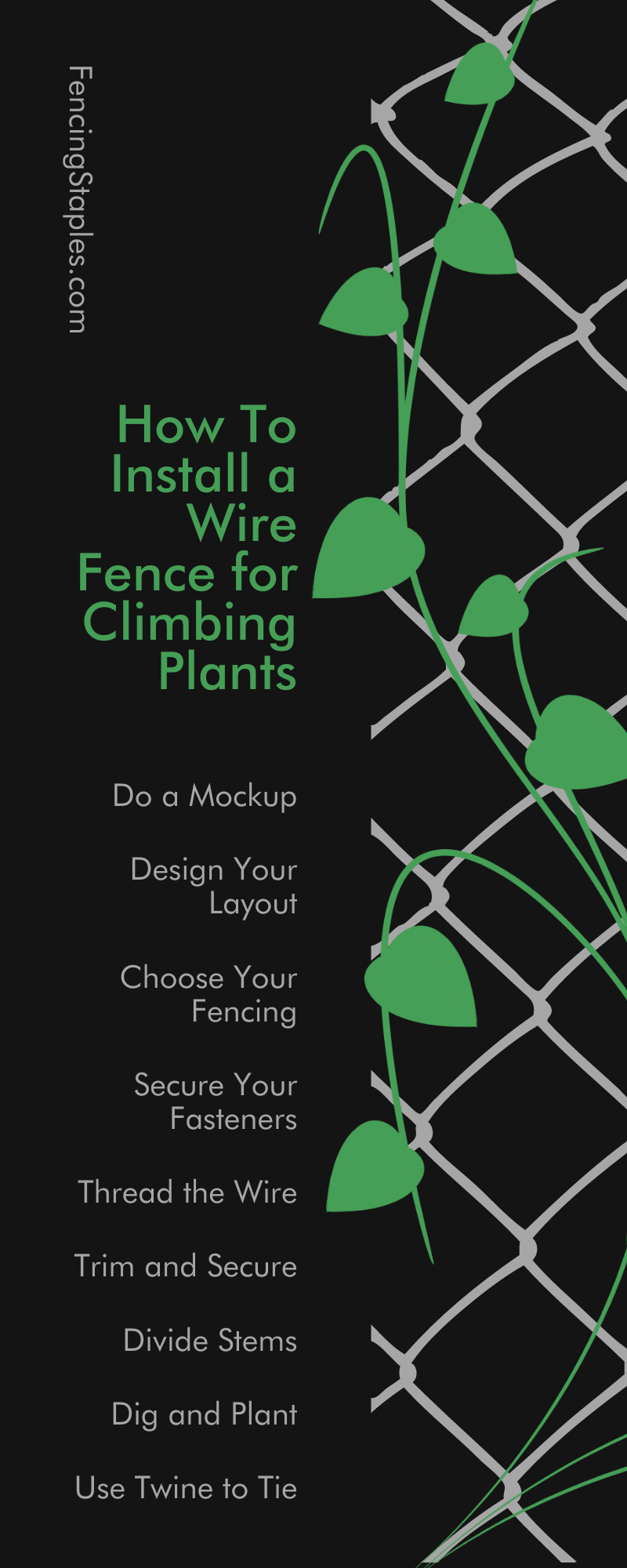If you’re into gardening but want something to expand your horizons, you might consider installing a wire fence. This fencing option can serve a dual purpose depending on what you plant. In the center of your garden, you can sow whatever you like, except for vining plants. Once you fill the inside of the garden with everything you want to plant, you can then plant your vines along the outermost border of the fence so they can thrive! Here’s how to install a wire fence for your climbing plants to get started right away with this project.
The first thing you’ll need to do is draw up a physical blueprint. Keep in mind what you want to do, and then start to shape up the plan by drawing it in. Keep in mind that you’ll be growing vining plants like cucumbers, squash, tomatoes, and grapes, so make sure to leave enough space for these vines to take shape.
This will give you a rough idea of the dimensions and space you’ll need to make your project happen. It will also help you determine if your garden measurements and spacing are suitable for the project. Having a clear plan will give you the insight you need moving forward to ensure everything meets your specifications and design, no matter how ornate.
You’ll want to map out all your measurements after making them. You can do this by making “X” marks with colored tape in the designated plots to give you a three-dimensional blueprint.
Then, you can start designing your garden how you want to. You can either use the same colored tape or another color to mark the places where you would like to build your designs so that you can start utilizing your space correctly. It’s one thing to imagine what your garden will look like and another to actually start planting.
If you start with a plan for building your garden and get the dimensions and design worked up, then you can begin to see the fruits of your labor. Make sure that you know where your crops will go and organize them so that they each have enough space to grow, while providing room for walkways.
To be honest, as long as it is sturdy, it doesn’t really matter what type of fencing you use. Most people choose wire fencing because it gives the vining plants something to climb and fill in. However, these plants can climb wood fencing as well! One fencing type you may want to stay away from is vinyl. Unless you are using pickets, the vining plants will not have anything to grapple to.
You’ll need to ensure that all eyehole fasteners are secured and measured correctly. These fasteners are in charge of holding your wire in place. They must allow a certain amount of tension on the wire so that when the vegetation grows and puts weight on the fence, the wire’s strength will distribute equally. This way, you can have multiple plants on the same line. Having a sturdy fence construction prevents the wire from snapping with excess weight on it.
Next, you’ll need to take your wire and tie it off to one end of the fence. You’ll secure it to the posts by either tying or fastening it with a staple to keep it in place. Whatever you choose to do, make sure you attach the line so that it will hold and remain taught through the seasons.
You will then thread the wire through each one of the eyeholes consecutively until you’ve made it through all of them. Then, secure the line on the opposite post just as you did initially. Make sure you fasten it down well so the line stays taut. You could use something sturdy like cat’s claw fasteners if you have wooden posts. That will keep everything in place nicely.
Inspect the perimeter of your fencing and your wire and trim off any unnecessary line sticking out. This is for your safety and the safety of others. This will also serve as an excellent time to check any parts that might be loose or inadequately secured and fasten them.
Now that you’ve got everything in order, you can start to divide out all of your vines. Make sure you’re spacing them along the line so they don’t grow into one another. This can cause them to choke each other, and you could end up with dead vines. It’s a good practice to give them a few feet in between one another so they have the space to grow freely.
Cultivate your dirt before you start digging so that your soil is well aerated. This will allow the plants to breathe and get nutrients and water. If you fail to do this, the dirt might get impacted, and then the plants will not get what they need and could die.
Next, you can dig and plant, but make sure not to pack the soil too tight. The water alone will settle the dirt. This will also allow the roots to spread out as the plant grows, which is what you want to enable them to absorb water and nutrients.
Finally, you’ll want to secure your plants in place. This goes for the upright staked plants out of the ground and for the vines. All plants are susceptible to falling over and breaking when they are under too much stress or pressure.
Most of this tension comes from the weight of the plant itself. When everything begins to fruit, that adds weight to the plant. This is where twine and staking come into play and can be very beneficial for your crop and your plant health overall.
These are just a few suggestions and instructions for how to install a wire fence for your climbing plants. With this method, you can make the most out of your garden and have a healthy harvest.
If you’re looking to install a wire fence for your climbing plants, check out the fence materials we offer. If you have other fence questions, Cat’s Claw Fasteners would be happy to help. Contact us for any of your fence building inquiries.

Whether you’re installing a wire fence covered in colorful climbing plants or sowing a diverse array of vegetables and flowers, SeedsNow offers a variety of seeds to bring your gardening vision to life. From fragrant jasmine to versatile cucumber, cultivate a garden that’s a symphony of colors, textures, and flavors with SeedsNow as your trusted partner.
Seeking insights? Cat’s Claw Fasteners is here to help! Contact us and reach our Head Cat Collector, Ralph, at ra***@***************rs.com. Stay informed with our blog posts and follow us on Facebook, Instagram, Pinterest, and Youtube for more exciting updates!
Read Next: Building supplies: An easy Guide for Fencing and Gate installation

© 2024 Cat's Claw Fasteners, LLC | All Rights Reserved - Built by Redemptive Software